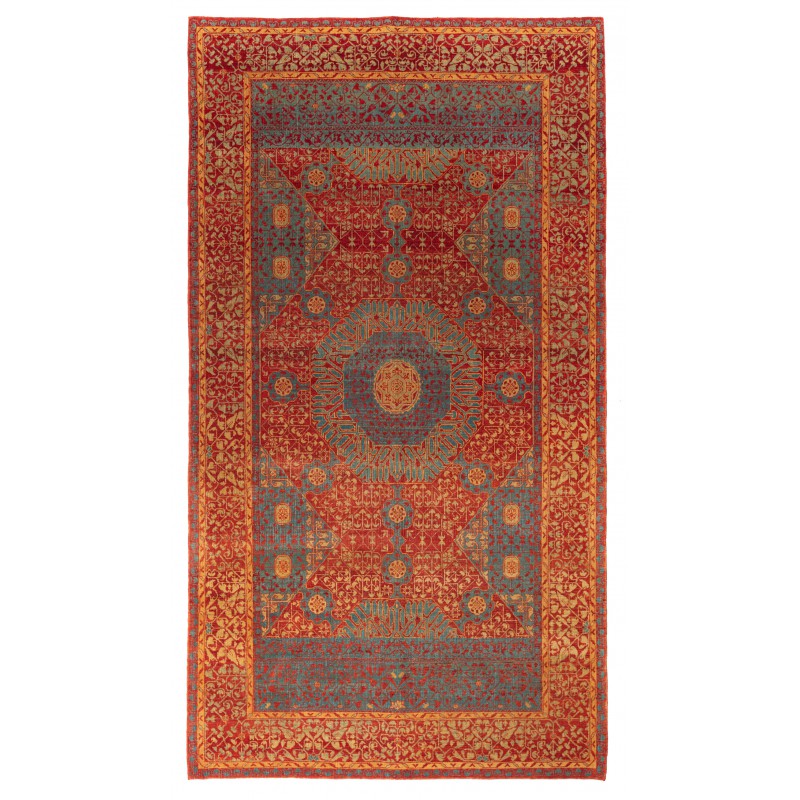
- Stock: In Stock
- Model: C31004
- サイズ: 154cm x 280cm
この絨毯の情報源は、Esin Atilによる書籍『ルネサンス・オブ・イスラム、マムルークの美術』、スミソニアン協会出版、ワシントンD.C.、1981年、No.128です。この中央に大きな八角形を持つ絨毯は、エジプトのカイロにあるマムルークスルタンによって16世紀初頭にデザインされました。ワシントンD.C.のテキスタイル博物館、R.16.2.8で展示されています。この例は、三分割のフィールドと広いボーダーを持つほぼ正方形のマムルーク絨毯のスタイルの発展を表しています。中央ユニットの上下にある長方形のバンドは狭く(中央ユニットの高さの1/6)、以前に見られた正方形の形式とは対照的にわずかに伸びた中心を作り出しています。ボーダーは区画されたデザインを無視した連続的なパターンを持っています。象牙色と黄色が伝統的な赤、緑、青に加わっていることから、この絨毯は他のものよりも後の時代のものと考えられます。ただし、同心円状の八角形を主題とし、パピルス植物に基づく花のモチーフを豊富に使用している点は、マムルーク絨毯のスタイルと装飾的特徴に従った伝統的なものです。ほぼ正方形の中央ユニットは、赤い地に青いパピルスの模様が施された大きな八角形でほとんど完全に覆われています。各側の中央には、茎によって内側の八角形に接続された8つの葉を持つメダリオンがあります。この八角形は、赤い地に緑のランセットの葉が描かれたもう1つの同じ要素を包み込んでいます。その内側には、象牙色のメダリオンがあり、その放射状の炎が黄色で表現されています。メダリオンの中心には、六弁のバラの花を持つ小さな八角形が囲まれています。角の三角形には、黄色いバラの花が付いた八角形の周りに赤いパピルスの模様があります。上部と下部の三角形を結ぶように、スタイライズされた蓮の花の巻物が2つあります。横帯には、さらにパピルスの模様が緑の地に赤で描かれたハート形の模様や花で交互に配置されています。横帯を囲むのはシェブロンの帯で、パピルスの葉で埋められた細いストリップが外縁に沿って垂直に走っています。ボーダーは青色で、赤い地に黄色のタッチがあり、横帯で使用されるモチーフの拡大版が表示されます。花の巻物は、ダブルガードボーダーを飾っています。1つは赤い地に青いパピルスがあり、もう1つは青と赤の葉が黄色い地に描かれています。象牙の中心を取り囲む黄金の光輪から始まる放射ユニットのダイナミズムは、絨毯の伝統に類を見ない鮮やかな色のリングを生み出し、万華鏡のような効果を生み出します。要素はほぼ顕微鏡レベルから進化し、外に向かってサイズが大きくなります。コーランの装飾でも同様の遠心力が観察され、宇宙的な意味合いを持ち、天上の光を象徴していると解釈されることがあります。このカーペットのカラースキームは、太陽の光が当たると宝石のような色調を持つ赤、青、緑、黄色のステンドグラス窓を思い起こさせます。また、マムルーク絨毯では、太陽の光線やオイルランプの明滅が表面に反射することで、その見た目とデザインが変化します。絨毯のデザインは、私たちのデザイナーによって解釈され、元の絨毯に合わせるために最適な色が使用されます。
The source of the rug comes from the book Renaissance of Islam, Art of the Mamluks, Esin Atil, Smithsonian Institution Press, Washington D.C., 1981 nr.128. This rug with a large central octagon was designed in the early 16th-century rug by Mamluk Sultane of Cairo, Egypt. It is exhibited at the Washington D.C. The Textile Museum, R.16.2.8. This example represents a stylistic development in the almost square Mamluk rug with a tripartite field and wide border. The rectangular bands above and below the central unit are narrower (one-sixth the height of the central unit) and create a slightly elongated center in contrast to the square format seen earlier; the border has a continuous pattern, which disregards the compartmentalized design. This features together with the addition of ivory and yellow to the traditional red, green, and blue-suggest that the rug is later in date than the others. However, the employment of a concentric octagon as the main theme and the abundant use of floral motifs based on papyrus plants are traditional and follow the stylistic and decorative features of Mamluk rugs. The nearly square central unit is almost completely covered by a large octagon with blue papyrus sprays on red ground. In the center of each side is an eight-lobed medallion attached by a stem to an inner octagon. This octagon, filled with green lancet leaves on a red ground, encloses another identical element, decorated with red papyrus motifs on a green ground. Inside is a fourth octagon with an ivory medallion, its radiating flames rendered in yellow. In the center of the medallion is an eight-pointed star enclosing a minute octagon with a six-petaled rosette. The corner triangles have red papyrus sprays placed around octagonal units with yellow rosettes. Two scrolls of stylized lotus blossoms join the triangles at the top and bottom. The transverse bands have additional papyrus motifs intermingled with heart-shaped motifs, split leaves, and blossoms, rendered in red on green ground. A chevron band encircles the transverse bands; thin strips, filled with papyrus leaves, run vertically between the bands along the outer edges. The border, executed in blue with touches of yellow on a red ground, displays an enlarged version of the motifs used in the transverse bands. Floral scrolls adorn the double guard borders: one has a blue papyrus on a red ground, and the other shows blue and red leaves on a yellow ground. The dynamism of the radiating units, evolving from an ivory core enclosed by a golden halo, creates a kaleidoscopic effect with brilliantly colored rings unequaled in any rug tradition. The elements evolve from an almost microscopic core and increase in size as they move outward. A similar centrifugal force is observed in illuminations of the Koran and can be interpreted as having cosmic implications and symbolizing celestial light. The color scheme of this carpet recalls the red, blue, green, and yellow stained-glass windows that burst into jewellike tones when lit by sunlight. Light is also an important factor in Mamluk rugs, for their appearance and design change as the rays of the sun and flicker of oil lamps play upon their surfaces. The design of the rug is interpreted by our designers, and the most appropriate colors to match the original are used for this rug.
